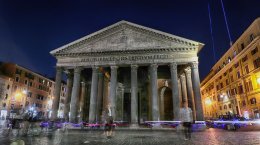The Golden Abode
The famous fire that in A.D. 64 destroyed the center of Rome and the History attributed to Nero, gave the extravagant emperor the opportunity to have the Domus Aurea built.
In an area of 80 hectares, which included both the Esquiline and the Palatine, Nero commissioned the best architects of that time – Celere and Severo – to carry-out an endless project under his supervision, where most of the space was dedicated to spectacular gardens with several pavilions used to host parties complete with vestibulum and stagnum.
The sumptuous imperial gardens alternated with vineyards and small woods that occupied most of the three hills of Rome and were characterized by an artificial lake on which, later, the Flavian Amphitheater was built.
Even if the Domus Aurea was particularly dispersive, the emperor nevertheless resided in his palaces located on the Palatine Hill.
It seems superfluous to say that the people hated the Domus Aurea because, due to its construction Nero had had all the temples present in the city as well as many others in Greece and Asia looted, in addition to the expropriation of land to the detriment of the citizens.
Regarding the project, the emperor was inspired by the maritime villa in Campania that had a series of buildings scattered within a territory, which offered the opportunity to include gardens, arcades, terraces and vestibules that embellished the property.
Indeed, the same solution was adopted for the Domus Aurea which took advantage of the Palatine Hill, the Velia, Colle Oppio and the Esquiline, to create nymphaeums, temples, porticos and terraces that embellished the imperial residence.
Near the Atrium Vestae, in the Roman Forum, there was the large Vestibulum, where the main entrance to the Domus Aurea was.
The entrance was dominated by the Colossus, a colossal statue of Nero that was positioned on the top of the Velia.
We must not forget the detail that Nero previously resided in the ‘Domus Transitoria’ which connected the buildings of the Palatine Hill with the ‘Horti Maecenatis’ but, due to the famous fire, the house was totally destroyed leaving the emperor with the decision to replace it with the Domus Aurea.
Nero’s guests could not fail to be ecstatic upon entering his property which had an authentic citadel in the center of Rome complete with cultivated fields, pastures, woods and vineyards.
But to the initial astonishment, another was added that was even more impressive when the guests realized that the inside of the buildings were all covered with gold and precious gems, the dining rooms were characterized by ceilings covered with ivory appropriately drilled to allow the fall of flower petals and perfumed essences.
The emperor, however, did not enjoy his Domus Aurea for a long time, because he died a short time after its completion, and the magnificent residence was destroyed by his successors.
In fact, the land was returned to the people even if not done so immediately. After Nero’s death, Otho continued to complete the Domus, spending the considerable sum of fifty million sesterces and, upon his death, the Emperor Vitellio, while criticizing the property, went on to live there.
Only with Vespasian, the residence of Nero stared to be destroyed, but the process lasted for over a decade while the Colosseum was built.
After the demolition of those many buildings, Vespasian had the work to complete the temple dedicated to Divo Claudio and Agrippina Minor resumed, and had the Domus Tiberiana transformed into a thermal building.
Traces of the Domus were lost until, at the end of the 15th century, a young man fell inside a hole on top of the Oppio hill causing him to fall inside a cavity full of painted figures. The discovery of the frescoes that had almost faded from time was random, but it gave a considerable boost to the creativity of artists such as Michelangelo, Raphael and Pinturicchio, who were able to study those ancient images.
The Domus
The emperors Tito and Traiano ordered the construction of the baths right above the Domus Aurea which, therefore, was somehow incorporated into the baths. Parts of Nero’s imperial building were buried and this allowed their preservation.
A pavilion of the immense Domus Aurea remains today on the Oppian Hill; it is considered the fulcrum of the complex because one of the many rooms, the ‘octagonal room’, is oriented exactly on the position that the sun assumes during the equinox of Autumn.
The various rooms are marked with names deriving from the most significant paintings that are present, for example, the “vault room of the civets”, the “golden vault room” and the “black vault room”.
At the beginning of the 16th century, during some works in a vineyard on the Oppio hill, the Laocoonte group was found, mentioned by Pliny the Elder in his “Natural History” where he identified it as an ornament of the Domus Aurea.
Today we can only guess through the decorations, the mosaics and the stuccos, the luxury that distinguished the Domus Aurea since its origins.
In the second half of the 18th century, Pope Clement XIII ordered the first regular excavations, while at the beginning of the following century the architect De Romanis was entrusted with the task of exploring and liberating about fifty rooms. Work that was revived a century later and that led to the discovery of many mysteries of Nero’s imperial residence.
The oriental pavilion, composed of a massive 153 rooms that extend for about 30 thousand square meters, has survived until today.
Currently, we can summarize the Domus Aurea only by its surviving parts that are:
• The building works of Nero’s Nymphaeum
• The pavilion under the Baths of Trajan on the Oppian hill
• A section of the Arcus Neroniani, namely part of the aqueduct located on the Celio.






